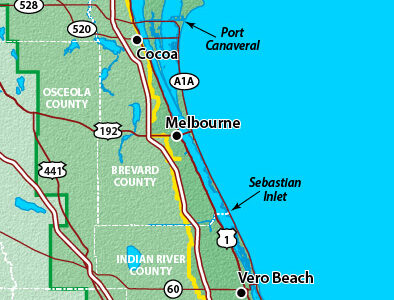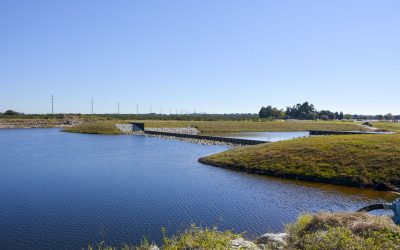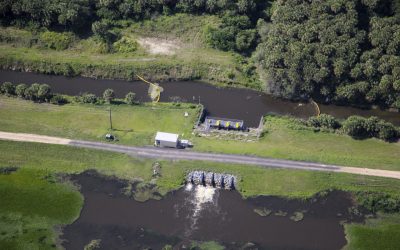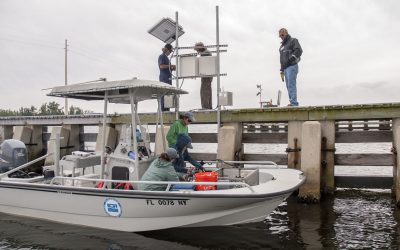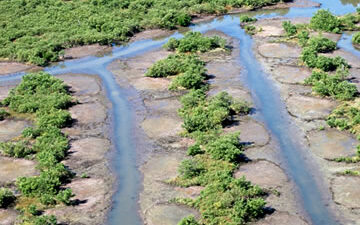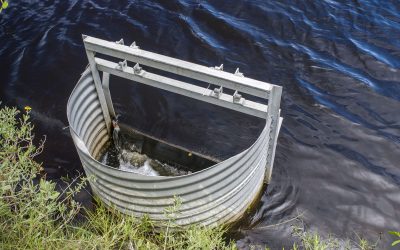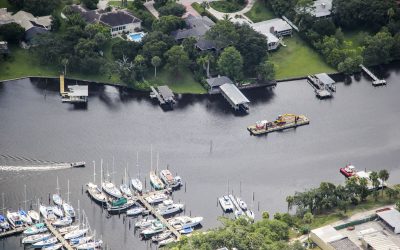The Indian River Lagoon has faced challenges over the years. By the 1970s, 75 percent of lagoon salt marshes were lost when dikes were built to separate 40,400 acres from the waterway to control mosquito breeding, which eliminated juvenile fish nursery grounds. In addition, freshwater discharges from St. Johns River marshes and Lake Okeechobee degraded shellfish habitat and carried soils and pollutants (primarily nitrogen and phosphorus) into the lagoon, fostering algal growth and killing seagrasses. Wastewater and stormwater discharges have deposited freshwater and pollutants, further promoting algal growth and seagrass destruction.
The St. Johns River Water Management District has worked with federal, state and local agencies to:
- Designate the lagoon as a Surface Water Improvement and Management Act basin in 1987.
- Create the Indian River Lagoon National Estuary Program (NEP) in 1990, which the District sponsored until 2015.
- Eliminate effluent discharges to the lagoon from more than 40 wastewater facilities.
- Reduce freshwater discharges from the St. Johns River into the lagoon.
- Buy 52,600 acres of environmentally endangered land within the lagoon’s watershed.
- Removed more than 95,000 cubic yards of muck from Melbourne’s Crane Creek in 1998, more than 380,000 cubic yards of muck were removed from Turkey Creek from 1999 to 2001, and about 2 million cubic yards were removed from the St. Sebastian River from 2006 to 2009. More than 600,000 cubic yards of muck was removed from the Eau Gallie River in a project that was completed in March 2019.
Other work in the lagoon includes the following:
Micco Water Management Area — Completed in spring 2016, this innovative park improves the quality of water discharged to the North Prong of the St. Sebastian River (an Indian River Lagoon tributary). Manmade lakes and created marshes treat storm water from a 21,000-acre watershed, capturing pollutants before they can reach the waterway. This is a cooperative project with the Florida Department of Environmental Protection, Florida Department of Transportation and Brevard County.
The Canal 1/Sawgrass Lake Water Management Area Project — Completed in fall 2015, this project diverts canal flows from the 100-square-mile Melbourne-Tillman Water Control District away from Turkey Creek and the lagoon, returning up to 43 percent of the drainage District’s discharges to the Upper St. Johns River Basin. As a result, fewer nutrients, suspended solids and freshwater reach the lagoon, improving the estuary’s water quality.
Dragline ditch restoration — Continued restoration of dragline ditched wetlands, to restore more natural hydrologic conditions, resulting in enhanced and expanded marsh habitat and greater production of fishes, crabs, shrimp, and the plants on which they depend, as well as expanded foraging area for wading and shore birds. Dragline ditches were cut to interrupt the life cycle of saltmarsh mosquitoes.
Mosquito impoundment reconnection — Continued reconnection of mosquito impoundments, allowing vast numbers of fishes, shrimps and crabs to regain access to historic wetland nurseries and feeding grounds. Birds and native wetland vegetation also benefit greatly from the establishment of a more natural hydrologic condition.


